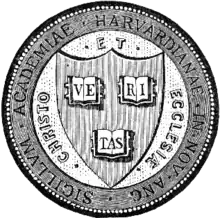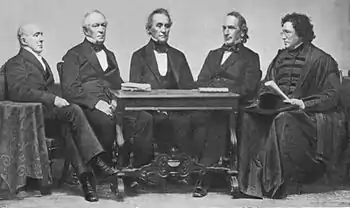
The President and Fellows of Harvard College (also called the Harvard Corporation or just the Corporation) is the smaller and more powerful of Harvard University's two governing boards. It refers to itself as the oldest corporation in the Western Hemisphere.[1] Together with the Board of Overseers, the two boards exercise institutional roles that, at most other colleges and universities, are more commonly consolidated into a single board of trustees.[2]
Although the institution it governs has grown into a university of which Harvard College is one component, the corporation's name remains "The President and Fellows of Harvard College".[3]
Structure
The Harvard Corporation is a 501(c)(3) and the owner of all of Harvard University's assets and real property.[4]
As a governing board, the Corporation traditionally functioned as an outside body whose members were not involved in the institution's daily life, meeting instead periodically to consult with the day-to-day head, the President of Harvard University, whom it appoints, and who also serves as a member. The Corporation is self-perpetuating, appointing new members to fill its own vacancies as they arise.
For most of its history, the Corporation consisted of six fellows in addition to the president. But after the presidency of Lawrence Summers from 2001 to 2006, and a large endowment decline after the Great Recession in 2008–2009, a year-long governance review was conducted. In December 2010, it announced that the Corporation's "composition, structure, and practices" would be altered: the number of fellows would increase from six to twelve, with prescribed terms of service, and several new committees would endeavor to improve the group's integration with the activities of the University as a whole, especially its long-term planning.[5]
History

Starting in 1636, the affairs and funds of Harvard College were managed by a committee of the Great and General Court of Massachusetts. In 1650, at the request of Harvard's first President Henry Dunster, the Great and General Court of Massachusetts issued the body a charter.[6]
The Charter of 1650 established the Harvard Corporation board which consisted of seven members: a President, five Fellows, and a Treasurer. The Corporation had the authority to manage the College's finances, real estate, and donations, act as a legal entity in courts of law, select officers and servants, and create orders and bylaws for the College, with the approval of the Board of Overseers.[7]
The founding members of the Harvard Corporation were respectively: Henry Dunster as President, Samuel Mather, Samuel Danforth, Jonathan Mitchell, Comfort Starr and Samuel Eaton as the five Fellows and Thomas Danforth as the Treasurer.[8] These men had, in perpetual succession, the duties of managing the College.
The 1780 Constitution of the Commonwealth of Massachusetts reaffirmed that, despite the change in government due to the American Revolution, the corporation would continue to "have, hold, use, exercise and enjoy" its property and legal privileges.[9] However it further noted that "nothing herein shall be construed to prevent the legislature of this commonwealth from making such alterations in the government of the said university."[10]
In 1805, the election of Henry Ware as Hollis Professor of Divinity placed the Corporation, then politically Federalist and religiously Unitarian, at odds with Massachusetts politics that was increasingly Democratic-Republican and still Trinitarian.[11]
In late 2023, the Corporation came under scrutiny by the House of Representatives. After a House Committee hearing on antisemitism, House members called for the presidents of Harvard and two other universities to resign.[12][13] In January 2024, the House Ways and Means Committee, which has jurisdiction over university tax status and endowments, challenged the tax status of Harvard and three other universities, over allegations of inadequate responses to antisemitism.[14][15]
Current membership
There are currently twelve members of the Corporation, including the University president, who sets the agenda but does not vote.[16][17]
| Name | Harvard Degree(s) | Year appointed | Occupation |
|---|---|---|---|
| Alan Garber | AB 1976, AM 1977, PhD 1988 | 2024[18] | interim President of Harvard University |
| Timothy R. Barakett, Treasurer | AB 1987, MBA 1993 | 2019[19] | former CEO of Atticus Capital |
| Kenneth Chenault | JD 1976 | 2014[20] | former CEO of American Express |
| Mariano-Florentino Cuéllar | AB 1993 | 2019[19] | President of the Carnegie Endowment for International Peace and former Justice of the Supreme Court of California |
| Paul Finnegan | AB 1975, MBA 1982 | 2012[21] | co-CEO of Madison Dearborn Partners |
| Carolyn Martin | None | 2018[22] | President Emerita of Amherst College |
| Karen Mills | AB 1975, MBA 1977 | 2014[20] | former Administrator of the U.S. Small Business Administration |
| Diana L. Nelson | AB 1985 | 2018[23] | chair of Carlson Holdings |
| Penny Pritzker, Senior Fellow | AB 1981 | 2018[22] | former United States Secretary of Commerce |
| Tracy P. Palandjian | AB 1993, MBA 1997 | 2022[24] | co-founder and CEO of Social Finance (consultancy) |
| Shirley M. Tilghman | LLD 2004 (Honorary) | 2016[25] | former president of Princeton University |
| Ted Wells | JD 1976, MBA 1976 | 2013[26] | partner at Paul, Weiss, Rifkind, Wharton & Garrison |
References
- ↑ "Harvard Corporation". www.harvard.edu. Harvard University. Retrieved November 8, 2022.
- ↑ "Leadership and Governance". Harvard University. Retrieved April 29, 2021.
- ↑ Chait, Richard P.; Daniel, D. Ronald; Lorsch, Jay W.; Rosovsky, Henry (May–June 2006). "Governing Harvard: A Harvard Magazine Roundtable". Harvard Magazine.
- ↑ Roberts, Andrea Suozzo, Alec Glassford, Ash Ngu, Brandon (May 9, 2013). "President And Fellows Of Harvard College - Nonprofit Explorer". ProPublica. Retrieved January 3, 2024.
{{cite web}}: CS1 maint: multiple names: authors list (link) - ↑ "Governance Review Culminates in Changes to Harvard Corporation". Harvard Gazette. Harvard University. December 6, 2010. Retrieved December 6, 2010.
- ↑ Whitehead, John S. (1971). The Separation of College and State: The Transformation of Columbia, Dartmouth, Harvard, and Yale from Quasi-Public to Private Institutions, 1776–1876 (Thesis).
- ↑ "Collection: Charters and legislative acts relating to the governance of Harvard | HOLLIS for".
- ↑ "Research Guides: Harvard Presidential Insignia: Harvard Charter of 1650".
- ↑ "Chapter V". Massachusetts Constitution.
- ↑ "Massachusetts Constitution". malegislature.gov. Retrieved December 26, 2023.
- ↑ Whitehead, John S. (1973). The Separation of College and State: Columbia, Dartmouth, Harvard, and Yale, 1776-1876. Yale University Press. ISBN 978-0-300-01606-2.
- ↑ Desk, JACKSON WALKER | The National (December 20, 2023). "Congress expanding Harvard probe to include plagiarism allegations against president". WPMI. Retrieved January 4, 2024.
- ↑ Moody, Josh. "Who Failed Whom at Harvard?". Inside Higher Ed. Retrieved January 9, 2024.
- ↑ Lorin, Janet (January 10, 2024). "Harvard, MIT Tax Status Probed by Congress Over Antisemitism".
- ↑ "House Panel Probes Harvard, UPenn, Cornell, MIT Tax Exemption". news.bloombergtax.com. Retrieved January 11, 2024.
- ↑ Dixon, Brandon J.; Parker, Claire E. (June 27, 2017). "The Harvard Corporation, Explained". The Harvard Crimson. Retrieved April 29, 2021.
- ↑ University, Harvard. "Harvard Corporation". Harvard University. Retrieved July 7, 2023.
- ↑ University, Harvard; william (January 2, 2024). "Statement from the Harvard Corporation: President Gay". Harvard University. Retrieved January 3, 2024.
- 1 2 "Two elected to Harvard Corporation". Harvard Gazette. Harvard University. February 11, 2019. Retrieved August 24, 2020.
- 1 2 "Kenneth Chenault and Karen Gordon Mills to join Harvard Corporation". Harvard Gazette. Harvard University. February 10, 2014. Retrieved June 15, 2015.
- ↑ "Finnegan elected to Corporation". Harvard Gazette. Harvard University. May 23, 2012. Retrieved June 15, 2015.
- 1 2 "Harvard Corporation elects two new members". Harvard Gazette. Harvard University. May 23, 2018. Retrieved October 20, 2018.
- ↑ "New Corporation member named". Harvard Gazette. Harvard University. February 10, 2020. Retrieved August 24, 2020.
- ↑ "Tracy Palandjian elected to Harvard Corporation". Harvard Gazette. Harvard University. April 4, 2022. Retrieved August 27, 2022.
- ↑ harvardgazette (December 7, 2015). "Tilghman named to Harvard Corporation". Harvard Gazette. Retrieved January 4, 2024.
- ↑ "Mathews and Wells elected to Harvard Corporation". Harvard Gazette. Harvard University. September 23, 2012. Retrieved August 24, 2020.